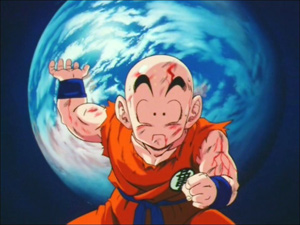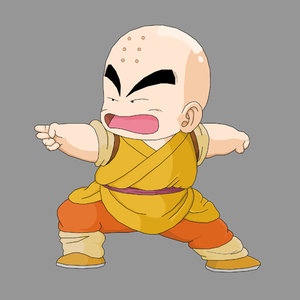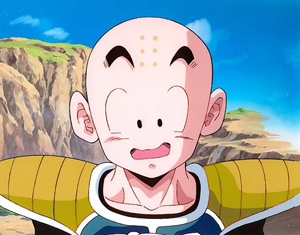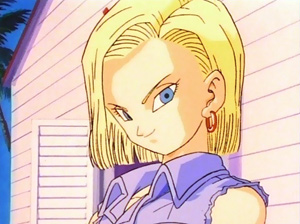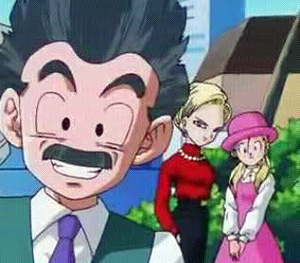Side by Side – Krillin
By reader request, here is an excerpt from The Dao of Dragon Ball that focuses on the character Krillin. This excerpt is from the Side by Side chapter in the Journey to the West section, where the characters from Dragon Ball are compared to those of Journey to the West.
Please note that the final version in the book may change.
Images seen in this blog post are not included in the book.
San Zuang / Krillin: A Warrior Monk
Speaking of warriors, another character who represents San Zuang in a few noticeable ways is Krillin, a monk from Orin Temple (Japanese: 多林寺, Orinji).
Krillin is comparable to San Zuang most evidently because they are both monks. San Zuang is a Buddhist monk of a Tang Dynasty China sect with Idealist origins, and Krillin is in the order of Orinji. His shaved head and outward appearance are testament to the discipline and strength of his character. These are traits cultivated in the temple environment and would aid him both in life as well as death (the afterlife). He is 13 when first introduced.
Krillin’s Japanese name (????, Kuririn) alludes to his martial monk heritage: “Kuri” means chestnut (as a pun expressed in the funny shape of his bald head), and “rin” means tree. His name references the Shaolin Temple of China, as Shorin is the name given to the Shaolin School’s branch in Japan. The Shorin Temple is a Zen Buddhist school that uses martial arts as an aid to its spiritual cultivation method of Buddha Law cultivation.
His name has other humorous aspects as well. “Shorin” in Japanese is written as ??, which in English means “Few Trees” or “Young Forest.” “Orin” in Japanese is written as ??, which in English means “Many Trees” or (essentially) “Expansive Forest.” So his name is an inverse spoof on the Shorin. Orinji also sounds like the borrowed English word “orange,” which is another of the countless and clever food references created by Toriyama.
Krillin has no last name and his parents are never mentioned. Combine this with the fact that he entered the monastery at a young age and it implies that he was most likely sent there as a child. This was and still is common practice for the Shorin and Shaolin Temple’s, as parents send their children there in the hope of the child having a more fortunate future. Although this is conjecture as it was not stated in the series.
Like other Buddhist temples, the monks of Orinji shave their head. This practice is part of their ordination into the temple and is known as tonsure. Shaving the head is an act of transformation for a new monk that enters the brotherhood and represents a physical renunciation of the external and vain attachments found in society, which are meaningless to a dedicated practitioner on the path of spiritual enlightenment. The tonsure is repeated throughout ones dedicated time of practice as the hair grows back.
The characteristic dots on Krillin’s forehead are not genuine dots, they are burn marks. These marks are characteristics of a monk who has sworn vows to uphold the Three Refuges of Buddhism, which include the Buddha, the Dharma (teachings), and Sangha (monastic community). During a ceremonial ritual known as “Jie Ban,” or “Shou Jie,” three cones of incense are inserted into their forehead and lit on fire. The Sinologist Herbert A. Giles wrote in his book The Civilization of China (2004 edition), “… The unfortunate novice being supported on both sides by priests who encourage him all the time to bear what must be excruciating pain.” As the incense smolders into the flesh they leave a permanent burn mark in the form of a circular scar.
At some point in their life a monk will retake the vows and receive three new marks alongside the first, which reaffirms their faith. Monks can have 3, 6, or 9 marks, and are representative of their time invested in cultivation and apparent level of wisdom. Krillin has 6 marks when we first see him. Another function of the marks was to signify a Buddhist monk to lay people in the case of death, so that they would be properly cremated, or to show others that he was a celibate cultivator. Giles also wrote, “The fully qualified priest receives a diploma, on the strength of which he may demand a day and a night’s board and lodging from the priests of any temple all over the empire.”
This ritual is no longer seen in China today as a result of the Cultural Revolution. The marks have been replaced by tattoos on less noticeable parts of the body for those who still want to follow the custom.
Krillin entered the temple at age 4 and left the monastic order at age 12 in search of a great master who could teach him the higher levels of the martial arts. He was picked on by the other students of the school and wanted to increase his powers in order to enact revenge. Also to impress girls. There is no greater teacher on Earth than Master Roshi, but Master Roshi’s whereabouts are unknown, so Krillin leaves Eastern Village to travel the world on a quest to find him. This can be likened to a monk traveling through India looking for a Law Master and esoteric sutras that contain formulas to attain higher levels of enlightenment, or to a martial pilgrim on the search for more advanced techniques. He wants to ascend but needs a true master to do it.
Krillin arrives on Master Roshi’s Island with the intention of becoming his disciple. He lands on the island and says, “My name’s Krillin and I’ve come all the way from a village in the east. Please allow me to be your student and fight like you.” Master Roshi is initially reticent, but Krillin wins him over by offering pornographic magazines as a gift, which the Master readily accepts. Compared to Goku, Krillin has a much more personal relationship with Master Roshi at first, primarily because of their shared interest in the ladies.
Yet even though a part of his mind is focused on women and worldly concerns for such a long time, and is less than perfectly pure as a result, Krillin spends his entire youth and much of his young adulthood without a girlfriend. As a result, he is free to train. And he is still a very good person by any regular standard, proven by the fact that he is the only character other than Goku shown able to wield the Spirit Bomb, which is an energy technique composed of righteous energy. Others may also be capable, but he is the only one given the opportunity to do so, and Goku believes in his ability to do so successfully.
It isn’t until Krillin’s late 20’s that he has his first date, which doesn’t exactly go well. However, he eventually does find a wife in Artificial Human 18, and starts a family with a beautiful daughter named Marron. Krillin had the opportunity to destroy Artificial Human 18, but when the crossroads presented itself, Krillin chose the more difficult and rewarding path. After a grueling ordeal Krillin ultimately saves her life and the two marry and start a family.
Krillin loves his wife, and despite the wicked actions of her past, still defends her to others. He explains in DBZ episode 209, “She’s not a robot. She’s a human with a few extra parts.” It is symbolic that when we see Krillin with his wife and daughter after a time jump of many years that he has let his hair grow out. Goku and the other warriors didn’t even know he had hair until then. Krillin explains that he had just been shaving it, as he was seemingly taught to live in such a manner at the temple, with its strict code of conduct. This indicates that Krillin stopped training the supernormal aspects of his life in order to become a family man. The standard of the martial monk no longer applied, although he still lived in a virtuous and noble manner.
Goku actually marries and starts a family before Krillin does, in his late-teens no less. Goku is completely unaware of what marriage means, being utterly oblivious to society’s conventions, but he goes along with it rather well when it unexpectedly enters his life. At the time Goku replied to Chi-Chi that he wanted a bride, he says that he “Thought ‘bride’ meant something to eat.” Chi-Chi didn’t realize his naivety and so holds him to the promise nevertheless. She confronts him at the 23rd World Martial Arts Tournament in order to cash in on the promise. Because the opportunity presented itself, Goku then proposes, as this is apparently what he was supposed to do according to society’s conventions. He probably would never have pursued a wife on his own. Krillin longed for a wife and yet it wasn’t until he finally gave up trying to find one that she arrived.
What’s most interesting is that Krillin left a monastic order in order to improve his martial arts skills and subsequently impress girls, with the ultimate goal of marriage and a family. Goku on the other hand unwittingly stumbled upon a wife and created a family, and yet spends the majority of his years in solitary cultivation away from the people who long to be by his side. His Saiyan nature and desire for self improvement meant that he was often alone, and this is how he preferred it, even though he had a family that wanted him at home. Krillin’s human nature and desire for a family meant that he was training in order to eliminate his loneliness, and once the pain was alleviated and the goal achieved, he stopped his training.
In the later portions of Dragon Ball and onward Krillin is seen as both a powerful warrior and as somewhat helpless to do anything about the dangers he faces. He’s always there to put up a fight, but against the opponents who come to destroy the Saiyans he really can’t do much. Goku and the other Saiyans are the only ones at a high enough power level to have an effect against the ever increasingly powerful enemies. For this reason Krillin is used more for comic relief and side stories, as well as on an occasional fetch quest for the dragon balls. He’s still an extremely integral character in the series, but more often than not he takes over the role of the “Where’s Goku!? He has to save us!” type character. In this manner he is just like San Zuang, crying for Monkey.
Still, despite his flaws and humorous failures, Krillin represents the unlimited potential of man and what can be accomplished through hard work and determination. His perseverance and willingness to try, even though he knows there’s little chance of success (often to buy time for his friends’ survival), has made him a fan favorite. He is the everyman.
Much like San Zuang, Krillin continues his journey on the difficult path, cognizant of his own weaknesses and fully aware of life’s hardships and rewards.
' . $comment->comment_content . '
'; } } else { echo 'No comments found.'; }